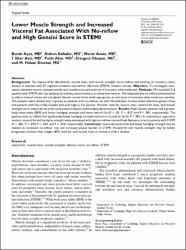Lower Muscle Strength and Increased Visceral Fat Associated With No-reflow and High Gensini Score in STEMI

View/
Date
2017Author
Ayça, BurakKafadar, Didem
Avşar, Murat
Avcı, I. İlker
Akın, Fatih
Okuyan, Ertuğrul
Dinçkal, M. Hakan
Metadata
Show full item recordAbstract
Background: The impact of fat distribution, muscle mass, and muscle strength on no-reflow and severity of coronary artery disease in patients with ST-segment elevation myocardial infarction (STEMI) remains unclear. Objective: To investigate association between muscle strength and fat and muscle mass and severity of coronary atherosclerosis. Methods: We included 218 patients with STEMI who had undergone primary percutaneous coronary intervention. We evaluated the no-reflow phenomenon in infarct-related artery and calculated Gensini scores from initial angiograms as indicative of coronary atherosclerosis severity. The patients were divided into 2 groups as patients with no-reflow and with thrombolysis in myocardial infarction grade 3 flow and patients with low (<55) Gensini and with high (55) Gensini. Patients' total fat, muscle mass, visceral fat mass, and muscle strength were measured via body composition analyzer and handgrip dynamometer. Results: High Gensini patients had a greater body mass index (BMI) and lower handgrip strength and more visceral fat (P = .05, P = .017, and P < .001, respectively). The patients with no-reflow had significantly lower handgrip strength and more visceral fat (both, P < .001). In multivariate regression analysis, visceral fat and handgrip strength were associated with high no-reflow rate and high Gensini scores in patients with STEMI (P = .001, P = .014, P = .022, and P = .010; respectively). Conclusion: Increased visceral fat and lower handgrip strength may be related to increased no-reflow rate and coronary plaque burden in STEMI. Visceral fat and muscle strength may be better prognostic markers than weight, BMI, total fat, and muscle mass in coronary artery disease.

















